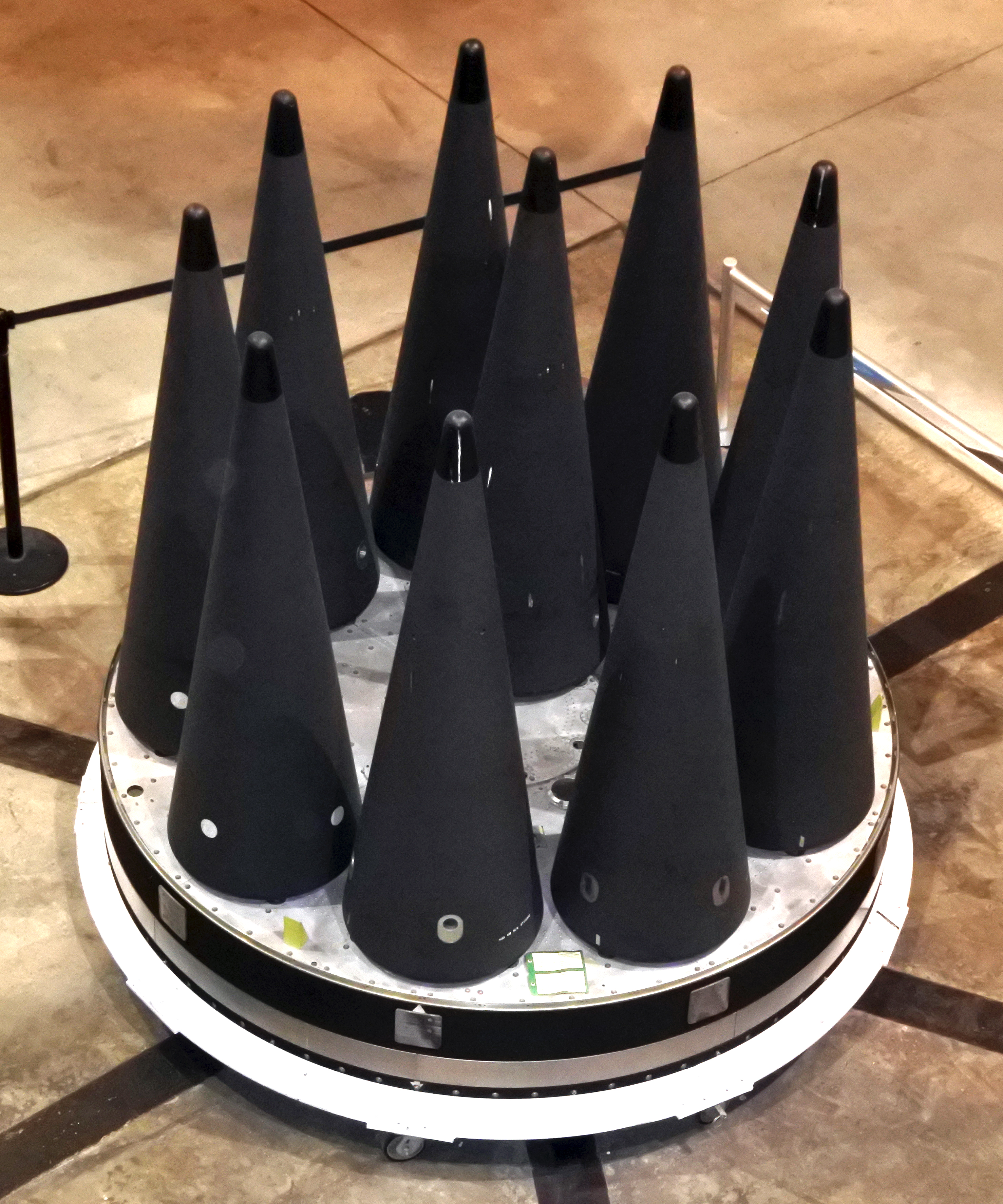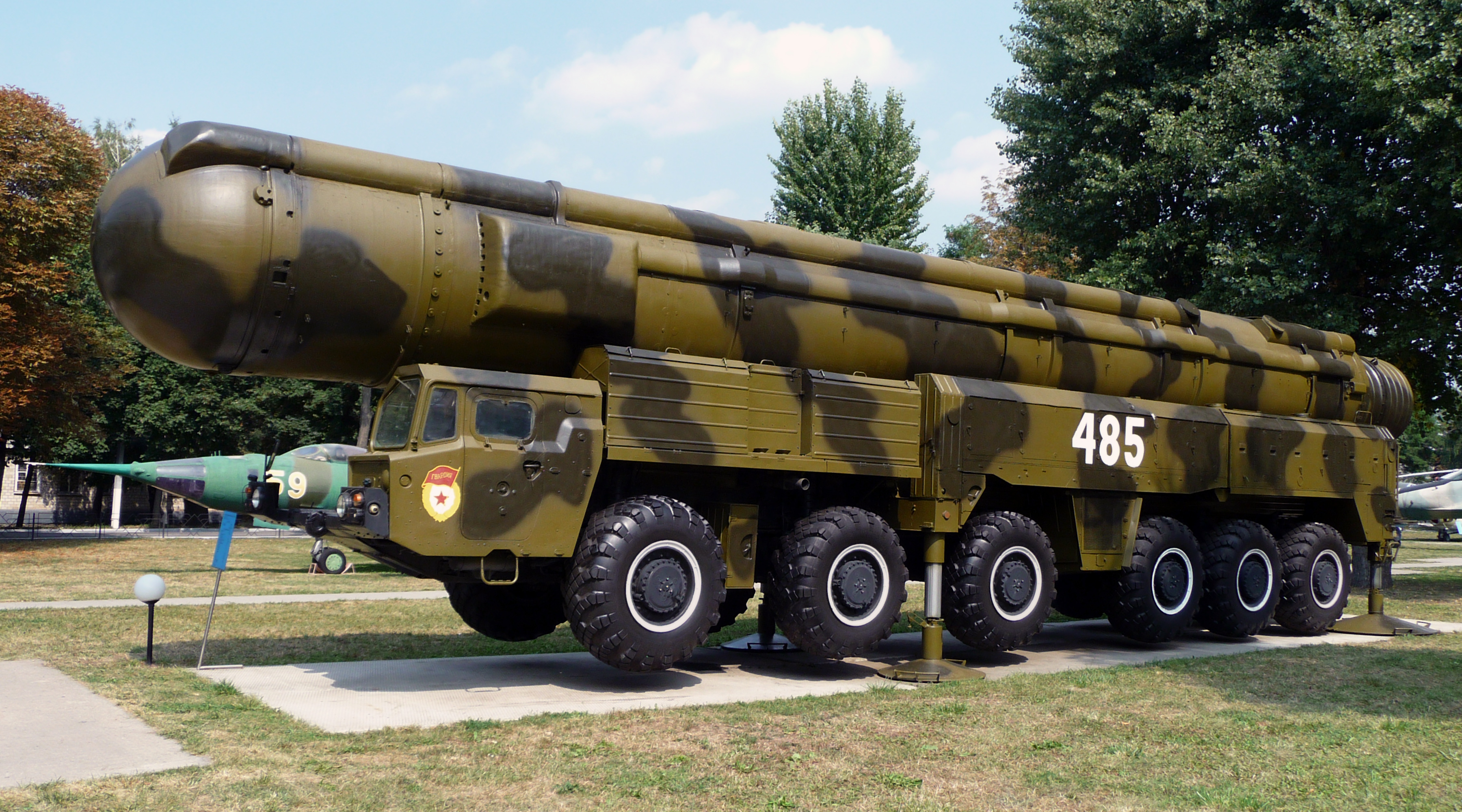|
Intermediate-Range Nuclear Forces Treaty
The Intermediate-Range Nuclear Forces Treaty (INF Treaty, formally the Treaty Between the United States of America and the Union of Soviet Socialist Republics on the Elimination of Their Intermediate-Range and Shorter-Range Missiles; / ДРСМД, ) was an arms control treaty between the United States and the Soviet Union (and its successor state, the Russian Federation). US President Ronald Reagan and Soviet General Secretary Mikhail Gorbachev signed the treaty on 8 December 1987. The US Senate approved the treaty on 27 May 1988, and Reagan and Gorbachev ratified it on 1 June 1988. The INF Treaty banned all of the two nations' land-based ballistic missiles, cruise missiles, and missile launchers with ranges of (short medium-range) and (intermediate-range). The treaty did not apply to air- or sea-launched missiles. By May 1991, the nations had eliminated 2,692 missiles, followed by 10 years of on-site verification inspections. Amidst continuing growth of China's missile ... [...More Info...] [...Related Items...] OR: [Wikipedia] [Google] [Baidu] |
Mikhail Gorbachev
Mikhail Sergeyevich Gorbachev (2 March 1931 – 30 August 2022) was a Soviet politician who served as the 8th and final leader of the Soviet Union from 1985 to the country's dissolution in 1991. He served as General Secretary of the Communist Party of the Soviet Union from 1985 and additionally as head of state beginning in 1988, as Chairman of the Presidium of the Supreme Soviet from 1988 to 1989, Chairman of the Supreme Soviet from 1989 to 1990 and the only President of the Soviet Union from 1990 to 1991. Ideologically, Gorbachev initially adhered to Marxism–Leninism but moved towards social democracy by the early 1990s. Gorbachev was born in Privolnoye, Russian SFSR, to a poor peasant family of Russian and Ukrainian heritage. Growing up under the rule of Joseph Stalin, in his youth he operated combine harvesters on a collective farm before joining the Communist Party, which then governed the Soviet Union as a one-party state. Studying at Moscow State University, ... [...More Info...] [...Related Items...] OR: [Wikipedia] [Google] [Baidu] |
Stockholm International Peace Research Institute
Stockholm International Peace Research Institute (SIPRI) is an international institute based in Stockholm. It was founded in 1966 and provides data, analysis and recommendations for armed conflict, military expenditure and arms trade as well as disarmament and arms control. The research is based on open sources and is directed to decision-makers, researchers, media and the interested public. SIPRI's organizational purpose is to conduct scientific research in issues on conflict and cooperation of importance for international peace and security, with the goal of contributing to an understanding for the conditions for a peaceful solution of international conflicts and sustainable peace. SIPRI was ranked among the top three non-US world-wide think tanks in 2014 by the University of Pennsylvania Lauder Institute's ''Global Go To Think Tanks Report.'' In 2020, SIPRI ranked 34th amongst think tanks globally. History In 1964, Prime Minister of Sweden Tage Erlander put forward the ... [...More Info...] [...Related Items...] OR: [Wikipedia] [Google] [Baidu] |
SS-5 Skean
The R-14 Chusovaya (russian: Чусовая) was a single stage Intermediate-range ballistic missile developed by the Soviet Union during the Cold War. It was given the NATO reporting name SS-5 Skean and was known by GRAU index 8K65. It was designed by Mikhail Yangel. Chusovaya is the name of a river in Russia. Line production was undertaken by Facility No. 1001 in Krasnoyarsk. Overview Development of the R-14 began by directive on 2 July 1958. The preliminary design was completed in December 1958, with flight tests beginning in June 1960 and completed in February 1961. The missile was accepted into service on 24 April 1961; initial operational capability for the first division of four launchers was achieved on 31 December 1961, with the first regiment organized the next day. By the end of 1962 two regiments were fully operational in the Ukraine and Latvia, with later surface launch pad sites in Kaliningrad and Belarus. A regiment consisted of two divisions, with eight laun ... [...More Info...] [...Related Items...] OR: [Wikipedia] [Google] [Baidu] |
SS-4 Sandal
The R-12 Dvina was a theatre ballistic missile developed and deployed by the Soviet Union during the Cold War. Its GRAU designation was 8K63 (8K63U or 8K63У in Cyrillic for silo-launched version), and it was given the NATO reporting name of SS-4 Sandal. The R-12 rocket provided the Soviet Union with the capability to attack targets at medium ranges with a megaton-class thermonuclear warhead and constituted the bulk of the Soviet offensive missile threat to Western Europe. Deployments of the R-12 missile in Cuba caused the Cuban Missile Crisis in 1962. A total of 2335 missiles were produced; all were destroyed in 1993 under the START II treaty. As well as the single-stage ballistic technology, the R-12 Dvina had a two-stage capability that allowed payloads to be placed into low Earth orbit. The Iranian Shahab-4 missile is likely an offshoot of the R-12 Dvina. History Beginning OKB-586 formed from a spin-off of portions of Sergei Korolev's OKB-1 production infrastructure ... [...More Info...] [...Related Items...] OR: [Wikipedia] [Google] [Baidu] |
Federation Of American Scientists
The Federation of American Scientists (FAS) is an American nonprofit global policy think tank with the stated intent of using science and scientific analysis to attempt to make the world more secure. FAS was founded in 1946 by scientists who worked on the Manhattan Project to develop the first atomic bombs. The Federation of American Scientists aims to reduce the amount of nuclear weapons that are in use, and prevent nuclear and radiological terrorism. They hope to present high standards for nuclear energy's safety and security, illuminate government secrecy practices, as well as track and eliminate the global illicit trade of conventional, nuclear, biological and chemical weapons. With 100 sponsors, the Federation of American Scientists says that it promotes a safer and more secure world by developing and advancing solutions to important science and technology security policy problems by educating the public and policy makers, and promoting transparency through research and an ... [...More Info...] [...Related Items...] OR: [Wikipedia] [Google] [Baidu] |
Intercontinental Ballistic Missile
An intercontinental ballistic missile (ICBM) is a ballistic missile with a range greater than , primarily designed for nuclear weapons delivery (delivering one or more thermonuclear warheads). Conventional, chemical, and biological weapons can also be delivered with varying effectiveness, but have never been deployed on ICBMs. Most modern designs support multiple independently targetable reentry vehicles (MIRVs), allowing a single missile to carry several warheads, each of which can strike a different target. Russia, the United States, China, France, India, the United Kingdom, and North Korea are the only countries known to have operational ICBMs. Early ICBMs had limited precision, which made them suitable for use only against the largest targets, such as cities. They were seen as a "safe" basing option, one that would keep the deterrent force close to home where it would be difficult to attack. Attacks against military targets (especially hardened ones) still demande ... [...More Info...] [...Related Items...] OR: [Wikipedia] [Google] [Baidu] |
Warhead
A warhead is the forward section of a device that contains the explosive agent or toxic (biological, chemical, or nuclear) material that is delivered by a missile, rocket, torpedo, or bomb. Classification Types of warheads include: * Explosive: An explosive charge is used to disintegrate the target, and damage surrounding areas with a blast wave. ** Conventional: Chemicals such as gunpowder and high explosives store significant energy within their molecular bonds. This energy can be released quickly by a trigger, such as an electric spark. Thermobaric weapons enhance the blast effect by utilizing the surrounding atmosphere in their explosive reactions. *** Blast: A strong shock wave is provided by the detonation of the explosive. *** Fragmentation: Metal fragments are projected at high velocity to cause damage or injury. *** Continuous rod: Metal bars welded on their ends form a compact cylinder of interconnected rods, which is violently expanded into a contiguous zig- ... [...More Info...] [...Related Items...] OR: [Wikipedia] [Google] [Baidu] |
Multiple Independently Targetable Reentry Vehicle
A multiple independently targetable reentry vehicle (MIRV) is an exoatmospheric ballistic missile payload containing several warheads, each capable of being aimed to hit a different target. The concept is almost invariably associated with intercontinental ballistic missiles carrying thermonuclear warheads, even if not strictly being limited to them. By contrast, a unitary warhead is a single warhead on a single missile. An intermediate case is the multiple reentry vehicle (MRV) missile which carries several warheads which are dispersed but not individually aimed. Only the United States, the United Kingdom, France, Russia, China and India are currently confirmed to have deployed MIRV missile systems. Pakistan is developing MIRV missile systems. Israel is suspected to possess or be in the process of developing MIRVs. The first true MIRV design was the Minuteman III, first successfully tested in 1968 and introduced into actual use in 1970. The Minuteman III held three sm ... [...More Info...] [...Related Items...] OR: [Wikipedia] [Google] [Baidu] |
Intermediate-range Ballistic Missile
An intermediate-range ballistic missile (IRBM) is a ballistic missile with a range of 3,000–5,500 km (1,864–3,418 miles), between a medium-range ballistic missile (MRBM) and an intercontinental ballistic missile (ICBM). Classifying ballistic missiles by range is done mostly for convenience; in principle there is very little difference between a low-performance ICBM and a high-performance IRBM, because decreasing payload mass can increase range over ICBM threshold. The range definition used here is used within the U.S. Missile Defense Agency. Some other sources include an additional category, the long-range ballistic missile (LRBM), to describe missiles with a range between IRBMs and true ICBMs. The more modern term theatre ballistic missile encompasses MRBMs and SRBMs, including any ballistic missile with a range under . The progenitor for the IRBM was the A4b winged rocket, based on the V-2 (officially called A4) rocket used by Nazi Germany at the end of World Wa ... [...More Info...] [...Related Items...] OR: [Wikipedia] [Google] [Baidu] |
RSD-10 Pioneer
The RSD-10 ''Pioneer'' (russian: ракета средней дальности (РСД) «Пионер» tr.: ''raketa sredney dalnosti (RSD) "Pioner"''; en, Medium-Range Missile "Pioneer") was an intermediate-range ballistic missile with a nuclear warhead, deployed by the Soviet Union from 1976 to 1988. It carried GRAU designation 15Ж45 (''15Zh45''). Its NATO reporting name was SS-20 Saber. Its deployment was a major cause of NATO's 'Double-Track Decision', which led to the deployment of more medium-range nuclear weapons in Western Europe. The RSD-10 was withdrawn from service under the 1987 Intermediate-Range Nuclear Forces Treaty. Specifications The missile was high, in diameter and weighed 37.1 tons. It was based on two solid-fuel fiberglass clad stages of the RT-21 Temp 2S (SS-16 ''Sinner''), so it was also known as the RT-21M ''Pioneer''. The missile's range was from initially; the final model had a maximum range of possibly . Initially the missile was fitted wi ... [...More Info...] [...Related Items...] OR: [Wikipedia] [Google] [Baidu] |
BBC News
BBC News is an operational business division of the British Broadcasting Corporation (BBC) responsible for the gathering and broadcasting of news and current affairs in the UK and around the world. The department is the world's largest broadcast news organisation and generates about 120 hours of radio and television output each day, as well as online news coverage. The service maintains 50 foreign news bureaus with more than 250 correspondents around the world. Deborah Turness has been the CEO of news and current affairs since September 2022. In 2019, it was reported in an Ofcom report that the BBC spent £136m on news during the period April 2018 to March 2019. BBC News' domestic, global and online news divisions are housed within the largest live newsroom in Europe, in Broadcasting House in central London. Parliamentary coverage is produced and broadcast from studios in London. Through BBC English Regions, the BBC also has regional centres across England and national news ... [...More Info...] [...Related Items...] OR: [Wikipedia] [Google] [Baidu] |





.jpg)


